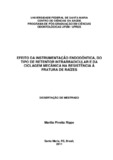| dc.creator | Rippe, Marilia Pivetta | |
| dc.date.accessioned | 2013-05-15 | |
| dc.date.available | 2013-05-15 | |
| dc.date.issued | 2011-03-16 | |
| dc.identifier.citation | RIPPE, Marilia Pivetta.Effects of root canal instrumentation, type of root post and mechanical cycling on the fracture strength of roots. 2011. 58 f. Dissertação (Mestrado em Odontologia) - Universidade Federal de Santa Maria, Santa Maria, 2011. | por |
| dc.identifier.uri | http://repositorio.ufsm.br/handle/1/6099 | |
| dc.description.abstract | The aim of this study was to evaluate the effect of root preparation strategy, the type of post and mechanical cycling on root fracture resistance. Eighty single-rooted human teeth were divided into 8 groups (n=10): G1 and G2 - hand file, glass fiber post, without and with mechanical cycling (MC) respectively; G3 and G4 - hand file, cast post and core, without and with MC respectively; G5 and G6 rotary file, glass fiber post, without and with MC respectively; G7 and G8 rotary file, cast post and core, without and with MC respectively. Obturation was performed by the lateral condensation technique. Root canals were prepared to a length of 10mm, using a #2 preparation bur of a tapered fiber glass post system. The following protocol was used for the cycling: 45o angle, 37°C, 88N, 4Hz, 2 million cycles. All groups were submitted to fracture resistance test in a device in 45°, at 0.05cm/min. The 3-way ANOVA showed the instrumentation strategy (p<0.03) and the post type (p<0.0001) had significant effects, however, mechanical cycling had not (p<0.29). The type of instrumentation caused effect on the fracture strength, only when the roots were restored with fiber glass post and cycled, with disadvantage for hand instrumentation. The cast post and core promoted higher fracture resistance, although showed more irreparable failures than roots restored with glass fiber post. | eng |
| dc.description.sponsorship | Coordenação de Aperfeiçoamento de Pessoal de Nível Superior | |
| dc.format | application/pdf | por |
| dc.language | por | por |
| dc.publisher | Universidade Federal de Santa Maria | por |
| dc.rights | Acesso Aberto | por |
| dc.subject | Pinos | por |
| dc.subject | Instrumentação endodôntica | por |
| dc.subject | Fadiga | por |
| dc.subject | Posts | eng |
| dc.subject | Root canal preparation | eng |
| dc.subject | Fatigue | eng |
| dc.title | Efeito da instrumentação endodôntica, do tipo de retentor intrarradicular e da ciclagem mecânica na resistência à fratura de raízes | por |
| dc.title.alternative | Effects of root canal instrumentation, type of root post and mechanical cycling on the fracture strength of roots | eng |
| dc.type | Dissertação | por |
| dc.description.resumo | O objetivo deste estudo foi avaliar o efeito da estratégia de preparo radicular, do tipo de pino e da ciclagem mecânica na resistência à fratura de raízes. Métodos: 80 raízes unirradiculares humanas foram divididas em 8 grupos (n=10): G1 e G2- lima manual, retentor de fibra de vidro (RFV), sem e com ciclagem mecânica (CM) respectivamente; G3 e G4- lima manual, retentor metálico fundido (RMF), sem e com CM respectivamente; G5 e G6- instrumento rotatório, RFV, sem e com CM respectivamente; G7 e G8- instrumento rotatório, RMF, sem e com CM respectivamente. A obturação foi realizada pela técnica da condensação lateral. Todos canais radiculares foram preparados para pino em 10 mm com a broca de preparo do sistema de pinos de fibra de vidro #2. Para a ciclagem, seguiu-se o protocolo: angulação 45°, 37 °C, 88 N, 4 Hz, 2 milhões de pulsos. Todos os grupos foram submetidos ao teste de resistência à fratura, em um dispositivo a 45º a uma velocidade de 0.05 cm/min até a falha ocorrer. A análise de variância 3 fatores mostrou que a estratégia de instrumentação (p<0,03) e o tipo de pino (p<0,0001) tiveram efeitos significativos, mas a ciclagem mecânica não (p<0,29). O tipo de instrumentação causou efeito na resistência à fratura, somente quando as raízes foram restauradas com pinos de fibra de vidro e cicladas, com prejuízo para a instrumentação manual. Os retentores metálicos fundidos proporcionaram maior resistência à fratura, contudo apresentaram mais falhas irreparáveis do que raízes restauradas com pino de fibra. | por |
| dc.contributor.advisor1 | Valandro, Luiz Felipe | |
| dc.contributor.advisor1Lattes | http://lattes.cnpq.br/0535309012233484 | por |
| dc.contributor.referee1 | May, Liliana Gressler | |
| dc.contributor.referee1Lattes | http://lattes.cnpq.br/6812578163990395 | por |
| dc.contributor.referee2 | Cenci, Tatiana Pereira | |
| dc.contributor.referee2Lattes | http://lattes.cnpq.br/6217846985830016 | por |
| dc.creator.Lattes | http://lattes.cnpq.br/3336921465345785 | por |
| dc.publisher.country | BR | por |
| dc.publisher.department | Odontologia | por |
| dc.publisher.initials | UFSM | por |
| dc.publisher.program | Programa de Pós-Graduação em Ciências Odontológicas | por |
| dc.subject.cnpq | CNPQ::CIENCIAS DA SAUDE::ODONTOLOGIA | por |


